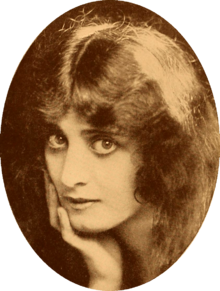Margarita Fischer
Margarita Fischer | |
|---|---|
 Moving Picture World, 1917 | |
| Born | Margarita Fischer February 12, 1886 Missouri Valley, Iowa, U.S. |
| Died | March 11, 1975 (aged 89) Encinitas, California, U.S. |
| Resting place | Forest Lawn Memorial Park |
| Other names | Margarieta Fisher Margarite Fisher Margurita Fisher Margarita Pollard |
| Occupation | Actress |
| Years active | 1901-1927 |
| Spouse | |
Margarita Fisher (née Fischer, February 12, 1886 – March 11, 1975) was an American actress in silent motion pictures and stage productions.[1] Newspapers sometimes referred to her as "Babe" Fischer.[2][3]
Early life[edit]
Margarita Fischer was born on February 12, 1886,[citation needed] in Missouri Valley, Iowa,[2] although a 1902 newspaper article referred to her as "a native of Silverton, Marion County", in Oregon.[3] Her parents were Johan (later John), a first-generation German-American hotelkeeper, and later noted minstrel, and Katherine "Kate" E. Fischer (née Hageny).[citation needed] She had an older sister, Dorothy,[citation needed] who was two years older and acted in productions with her in their childhood.[4]
Theater[edit]
As a child performer, and later as an ingenue star of the stage, Fischer was widely regarded in stock company groups of the Pacific Coast.[citation needed] When she was eight years old, a theatrical manager began using her in "heavy dramatic roles". Billed as "The Wonder Child", she continued in that pattern for several years.[5] Fischer made her stage debut in Portland, Oregon, in the child role of Adrienne in The Celebrated Case.[6] In 1901, she became the leading lady for the Fischer-Van Cleve Company.[2] Her rapidly growing popularity led to her father forming the Margarita Fischer Stock Company. The theatrical group toured up and down the Pacific Coast for a number of years.[citation needed] After her father's death, Fischer acted in several stock companies, including one headed by Grace George.[4]
After Fischer began performing in vaudeville, she met her eventual husband, film director Harry A. Pollard. They formed a team that performed the sketch "When Hearts Are Trumps" in "the principal vaudeville circuits".[4] Some years later the two met again, as actors with the Selig Polyscape Company, with the Imp Company in New York, New York, and even later, with Universal Pictures.
Motion pictures[edit]
When Fischer left vaudeville, she began working in films for the Selig Polyscope Company in Chicago.[4] She was in Hollywood silent films from at least 1910 until 1927. Her first screen experience began with the American Company. There followed 3 years as a leading woman for Universal. In 1913 she starred in How Men Propose written and directed by Lois Weber for Universal, which at the time was still based on the east coast. When the American Beauty Company was organized she was engaged for each of the star feminine roles.
She is well known for her role as an African-American slave girl in the Harriet Beecher Stowe three-reel epic Uncle Tom's Cabin. She was co-featured with Harry Pollard in this Universal feature. It was in this role, as Eliza, that Fischer won a long-term contract with the American Film Company in Santa Barbara, California. She received international acclaim as the American Beauty of the screen. Her face was pictured in the heart of a rose, which became one of the movie's trade marks. Pollard directed the Universal superproduction of Uncle Tom's Cabin which was released in 1927. This time Margarita was cast in the more mature role of Eliza.
Other of her motion pictures of note include Lost: A Union Suit (1914), A Joke On Jane (1914), The Quest (1915), Robinson Crusoe (1917), Impossible Susan (1918), Trixie From Broadway (1919), The Thirtieth Piece of Silver (1920), and Any Woman (1925). In April 1916 Fischer and her husband launched the Pollard Picture Plays Corporation. Pollard directed, Margarita acted, and director/producer George W. Lederer was their protégé. Their initial production was The Pearl of Paradise. It was staged in Los Angeles, Honolulu, and the South Sea Islands.
Later years and death[edit]
During World War I Fischer changed the spelling of her last name to Fisher because of the anti-German sentiment in America. She is sometimes credited as Margarieta Fisher, Marguerite Fisher,[7] Margarite Fisher, and Margurita Fisher.
In 1944, she was living in San Diego and was a registered Republican.[citation needed]
Fischer died in Encinitas, California of heart disease in 1975. She was interred at Forest Lawn Memorial Park.[8]
Gallery[edit]
-
Miss Jacky of the Navy (1916)
-
Miss Jacky of the Army (1917)
-
Name change during the war.
-
Put Up Your Hands (1919)
Filmography[edit]
|
|
References[edit]
- ^ Margarita Fischer: a biography of the silent film star by Teresa St. Romain c. 2008; McFarland Books
- ^ a b c "'Babe' Fischer's Career". Statesman Journal. Oregon, Salem. December 1, 1901. p. 4. Retrieved May 18, 2021 – via Newspapers.com.
- ^ a b "Babe Fischer To-Night". Albany Democrat. Oregon, Albany. November 7, 1902. p. 7. Retrieved May 18, 2021 – via Newspapers.com.
- ^ a b c d "At the Star". The Daily Chronicle. Illinois, De Kalb. April 23, 1915. p. 6. Retrieved May 18, 2021 – via Newspapers.com.
- ^ "Reverse English Used in One Star's Case". The Salt Lake Tribune. May 31, 1925. p. 48. Retrieved May 18, 2021 – via Newspapers.com.
- ^ "Famous 'Topsy' returns to screen in role of 'Eliza'". The Los Angeles Times. April 10, 1927. p. 59. Retrieved May 19, 2021 – via Newspapers.com.
- ^ Blake, Michael F. (1998). "The Films of Lon Chaney". Vestal Press Inc. Page 3. ISBN 1-879511-26-6.
- ^ https://thecoastnews.com/rancho-buena-vista-adobe-home-of-silent-film-star-margarita-fischer/
- Sandusky, Ohio Star-Journal, Saturday, April 8, 1916, Page 10.
- Syracuse, New York Herald, "Topsy Grows To Eliza In Movie", Sunday Morning, September 28, 1930.




